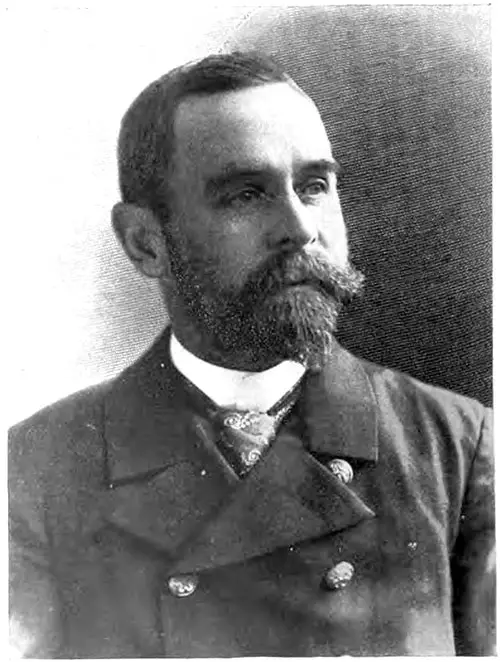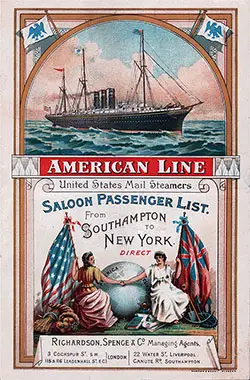Captain John C. Jamison

Captain Jamison of the New York. The Great Atlantic Liners, May 1895. GGA Image ID # 12e6a4566e
The American Line is comparatively a new departure, its inception dating only some two years back. But its newness is chiefly a matter of name, the International Steam Navigation Company and the Inman Line, of which it is composed, having been long in existence.
A Few of the Voyages Commanded by Captain John C. Jamison

1893-06-03 SS New York Passenger List
- Steamship Line: American Line
- Class of Passengers: Saloon
- Date of Departure: 3 June 1893
- Route: Southampton to New York
- Commander: Captain John C. Jamison

1893-08-19 SS New York Passenger List
- Steamship Line: American Line
- Class of Passengers: Second Cabin
- Date of Departure: 19 August 1893
- Route: Southampton to New York
- Commander: Captain John C. Jamison

1899-10-18 SS St. Paul Passenger List
- Steamship Line: American Line
- Class of Passengers: Saloon
- Date of Departure: 18 October 1899
- Route: New York to Southampton
- Commander: Captain John C. Jamison

1901-09-28 SS St. Paul Passenger List
- Steamship Line: American Line
- Class of Passengers: Saloon
- Date of Departure: 28 September 1901
- Route: Southampton to New York via Cherbourg
- Commander: Captain John C. Jamison

1902-12-06 SS St. Paul Passenger List
- Steamship Line: American Line
- Class of Passengers: Saloon
- Date of Departure: 6 December 1902
- Route: Southampton to New York via Cherbourg
- Commander: Captain John C. Jamison

1907-10-26 SS St. Louis Passenger List
- Steamship Line: American Line
- Class of Passengers: First Class
- Date of Departure: 26 October 1907
- Route: Southampton to New York via Cherbourg
- Commander: Captain John C. Jamison

1911-09-23 SS St. Louis Passenger List
- Steamship Line: American Line
- Class of Passengers: First Class
- Date of Departure: 23 September 1911
- Route: Southampton to New York via Cherbourg
- Commander: Captain John C. Jamison

1912-09-21 SS St. Louis Passenger List
- Steamship Line: American Line
- Class of Passengers: First Class
- Date of Departure: 21 September 1912
- Route: Southampton and Cherbourg to New York
- Commander: Captain John C. Jamison

1915-05-29 SS St. Louis Passenger List
- Steamship Line: American Line
- Class of Passengers: Second Class
- Date of Departure: 29 May 1915
- Route: Liverpool to New York
- Commander: Captain John C. Jamison
The company owns a number of first-class " liners," of which the St. Paul and the Paris are good types. They are mail steamers, subsidized by the United States Government, and run between Southampton and New York.
But in connection with the same company runs the old Red Star Line of Belgian steamers, which carry the Belgian flag, of which I shall have more to say presently.
In a talk, not long ago, with Captain John C. Jamison, the commander of the St. Paul, I learned that the American Line gets its subsidy from the United States Government on condition—for one thing—that it trains a certain number of American boys to the sea, and always carries a stipulated proportion of American seamen, or seamen who are American citizens.
" In the Si. Paul," said Captain Jamison, " we carry twelve cadets — one cadet for every thousand tons of the ship's measurement. We get a nice, well-behaved class of toys, and hope to turn them into good officers.
We are making quartermasters of them. But as the experiment has only been in operation two years, I can't say much as to its practical results."
As regards the ship's company, Captain Jamison said one-half must be American citizens, and the proportion increases year by year. " We engage our sailors and stewards on this side : the engineers, firemen, and stokers are all taken on at New York. The heads of the different departments, doctors, pursers, etc., are all citizens."
Regarding the employment of foreigners on the American Line, Captain Jamison said he always preferred American or English sailors; and for the British sailor he had a compliment that is worth repeating at the present time. He was speaking of him as a decreasing quantity. "
English boys, like American boys," he remarked, "are finding something better to do on shore, and 'do not take to sea so eagerly as they used to do. For some things it is a pity," he added, " for there is not a better sailor in existence than the English sailor.
His achievements in the past have been a glory to the nation, and he would do again what he has done before if the need came."
As to his own doings, Captain Jamison is hard to draw. He is a native of New York, and began his salt-sea career as an apprentice on board a Sandy Hook pilot-cutter. But after a year of that life — and there are not many harder—he came to the conclusion that he was not cut out for a pilot.
For many years after that he knew the life of sailing ships only, in which he went nearly all over the world. His last sailing vessel., the Charlotte, of which he was first officer, was wrecked on the "still vext " Bermudas.
This was the climax of a sort of record trip — for slowness — across the Atlantic, the Charlotte. having taken a hundred and fifteen days from Leghorn to her funeral.
After this, Captain Jamison decided to have nothing more to do with sailing ships. " Steamships," said he, " are safer. You have more control of them. You can turn them as you like, while in a sailer you are at the mercy of the winds. Hence there is less danger in a steamer."
He entered the service of the International Navigation Company in 1876, as second officer, and four years later was given his first command. This was the Vaderland, of the old Red Star Line.
It ran between New York and Antwerp. He subsequently had command of other ships of the same line. When the Paris and New York were placed under the American flag he went to Liverpool and took charge of the latter on her last trip from that port. Finally, a year ago, when the St Paul was being finished, he was appointed captain of her, and he has been on her ever since.
Captain Jamison is proud of the possession of a binocular glass, a present from the British Government for service rendered to the crew of an English steamship, which had been in collision with a boat belonging to the Hamburg America Line. "
She was one of the Dominion Line ships," said Captain Jamison. "I never saw such a ludicrous sight as she presented in all my life. Her bows had been completely cut off, and they had tried to cover up the opening with canvas and boards, and so get her home.
It was a plucky thing to do; but they found she was unmanageable, and rapidly filling with water. Up to the last, however, they seemed loth to abandon her. But they were obliged to do so at last.
There were some eighteen or nineteen men on board, and we succeeded in saving them all, although the sea was running so high that they had to jump one by one into the sea to be drawn by life-lines into the boat. Our men were out four hours rescuing them. The officer in charge of the boat had a present of a gold watch for the part he took in the rescue, and the crew got presents of money."
Regarding the speed of the St. Paul, Captain Jamison said, "We have made a number of voyages with an average speed of over 20 knots, or, to be exact, 20 3/4 knots. But the St. Paul's record passage was done at the rate of 21.07 knots."
